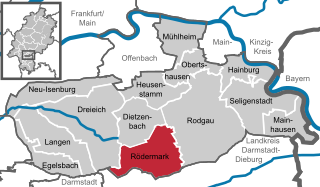
Rödermark is a town in the Offenbach district in the Regierungsbezirk of Darmstadt in Hesse, Germany, southeast of Frankfurt am Main and northeast of Darmstadt.

Mainz Hauptbahnhof is a railway station for the city of Mainz in the German state of Rhineland-Palatinate. It is used by about 60,000 travelers and visitors each day and is therefore by far the busiest station in Rhineland-Palatinate. The station was a trial area for a CCTV scheme using automated face recognition.

The Rhine-Main S-Bahn system is an integrated rapid transit and commuter train system for the Frankfurt/Rhine-Main region, which includes the cities Frankfurt am Main, Wiesbaden, Mainz, Offenbach am Main, Hanau and Darmstadt. The network comprises nine S-Bahn lines, eight of which currently travel through the cornerstone of the system, a tunnel through central Frankfurt. The first section of this tunnel was opened on May 28, 1978. Further tunnel sections were opened in 1983 and 1990, before its completion in 1992. The system belongs to the Rhein-Main-Verkehrsverbund (RMV) and is operated by DB Regio, a subsidiary of Deutsche Bahn.

Darmstadt Hauptbahnhof is the main railway station in the German city Darmstadt. After Frankfurt Hbf and Wiesbaden Hbf, it is the third largest station in the state of Hesse with 35,000 passengers and 220 trains per day.
The Main Railway is a 37.5 km-long double-track electrified railway line, which runs on the south side of the river Main from Mainz to Frankfurt central station.

The Hessian Ludwig Railway or HLB with its network of 697 kilometres of railway was one of the largest privately owned railway companies in Germany.
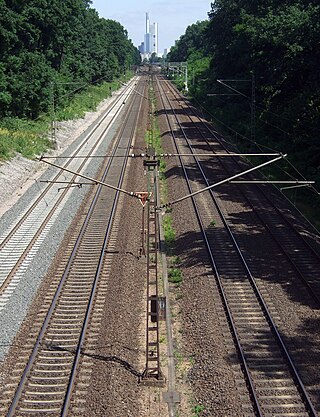
The Main-Neckar Railway is a main line railway west of the Odenwald in the Upper Rhine Plain of Germany that connects Frankfurt am Main to Heidelberg via Darmstadt, Bensheim and Weinheim. It was opened in 1846 and is one of the oldest railways in Germany.

The Würzburg–Aschaffenburg railway is an 89 kilometre-long railway line in the Bavarian province of Lower Franconia. It runs from Würzburg via Gemünden (Main) to Aschaffenburg. It is particularly important for long-distance and goods traffic because it links the Rhine-Main conurbation immediately northwest of Aschaffenburg with the Lower Franconian city of Würzburg and beyond it to the metropoles of Nuremberg and Munich. The German name derives from the fact that it initially runs parallel to the River Main and then cuts through the Spessart hills. It was opened on 22 June 1854 by the Frankfurt-Hanau Railway Company and is one of the oldest railways in Germany.
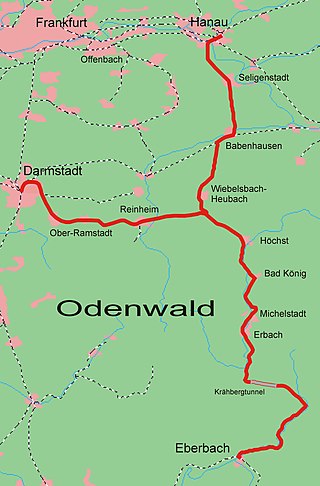
The Odenwald Railway is a mainly single-tracked main line from Darmstadt and Hanau to Eberbach on the River Neckar, which crosses the Odenwald mountains in the German states of Hesse and Baden-Württemberg. Since 1882 the route has been operated throughout as a standard gauge line and since 2005 has been worked by diesel multiples owned by the VIAS private railway company.
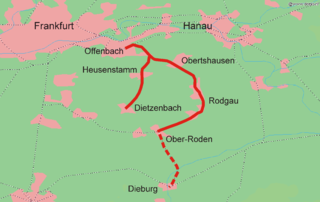
The Rodgau Railway (Rodgaubahn) is a railway line that runs from Offenbach Central Station via Rodgau to Rödermark-Ober-Roden in the German state of Hesse. The name Rodgaubahn is derived from the medieval name of Rodgau, part of the former Maingau, which the line passes through for its whole length.

The Mainz bypass railway is a bypass around the Mainz Hauptbahnhof node primarily used for freight in the German states of Hesse and Rhineland Palatinate.

Rüsselsheim station is a transit station in the town of Rüsselsheim in the German state of Hesse on the Main Railway from Mainz to Frankfurt am Main. It is classified by Deutsche Bahn as a category 3 station. The station is served by the Rhine-Main S-Bahn and by regional trains. There is another station in Rüsselsheim, Rüsselsheim-Opelwerk station, which is served by S-Bahn trains only.

Mainz-Bischofsheim station is the station of the town of Bischofsheim in the German state of Hesse on the Main Railway from Mainz to Frankfurt am Main. It is classified by Deutsche Bahn as a category 4 station. The station is served by the S-Bahn and regional trains. The station was opened at its current location in 1904.

Mainz Römisches Theater station is a station in the city of Mainz, the capital of the German state of Rhineland-Palatinate on the Main Railway from Mainz to Frankfurt am Main. It is the most important station in the city after Mainz Hauptbahnhof. It is classified by Deutsche Bahn as a category 3 station. The station is served by S-Bahn and regional trains.

Mainz-Gustavsburg station is the station of the town of Ginsheim-Gustavsburg in the German state of Hesse on the Main Railway from Mainz to Frankfurt am Main. It is classified by Deutsche Bahn as a category 5 station. The station is served by the S-Bahn and some regional trains. The station was opened at its current location in 1858.
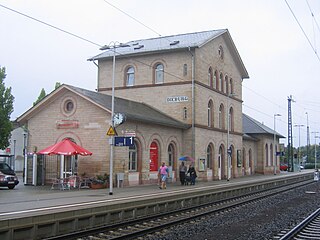
Dieburg station is located in the town of Dieburg in the German state of Hesse on the Rhine-Main Railway, which runs from Mainz via Darmstadt to Aschaffenburg. The Rodgau Railway from Offenbach am Main now ends here. The station is classified by Deutsche Bahn as a category 4 station. It is served only by local trains.

Hanau West station is the oldest station in the city of Hanau in the German state of Hesse. It was opened in 1848 and is located on the 17.9 kilometre mark of the Frankfurt Süd–Aschaffenburg railway. Operationally, since the 1970s it has been classified as a Haltepunkt ("halt"). The station is classified by Deutsche Bahn (DB) as a category 5 station.

Rödermark-Ober Roden station is the station of the Rödermark suburb of Ober-Roden in the German state of Hesse. It is the southern terminus of line S1 of the Rhine-Main S-Bahn and a stop for Regionalbahn services on the Dreieich Railway. It is classified in station category 4 and is a hub for public transport. The station building is a listed building.
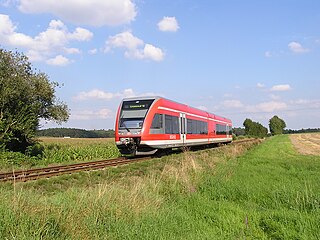
The Dreieich Railway (Dreieichbahn) is a single-track, non-electrified branch line in the Frankfurt Rhine-Main area in the German state of Hesse. It connects Dreieich-Buchschlag on the Main-Neckar Railway with Rödermark-Ober Roden on the Rodgau Railway. Colloquially, the RMV route 61 service is referred to as the Dreieichbahn, which continued beyond Ober-Roden on the Rodgau Railway to Dieburg.

The Pfungstadt Railway (Pfungstadtbahn) is a single-track branch line that branches off the Main-Neckar Railway in Darmstadt-Eberstadt and runs to a station on the eastern edge of the inner town of Pfungstadt, in Hesse, Germany.




















